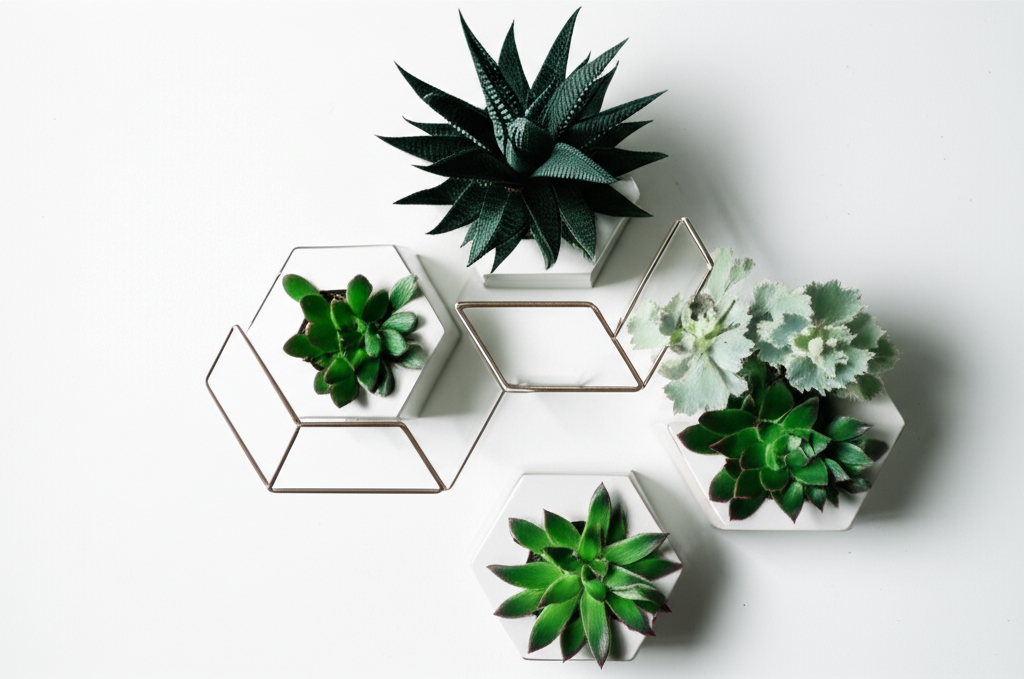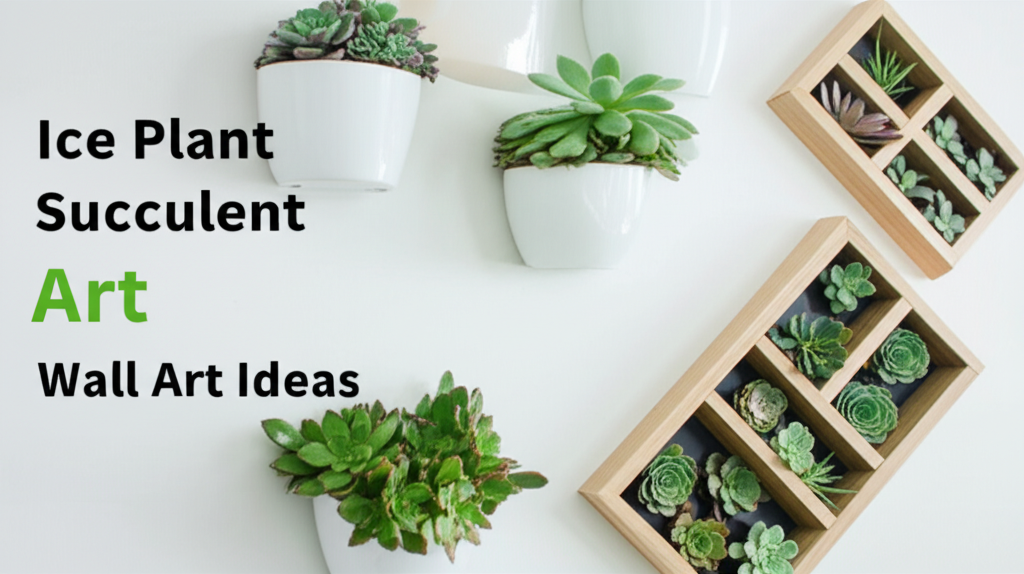The Allure of Ice Plant Succulent Wall Art
In the ever-evolving world of interior design, living art is making a significant comeback. Among the most captivating and low-maintenance options is succulent wall art, and at its forefront is the mesmerizing Ice Plant (Delosperma). Known for its jewel-like, water-filled cells that glisten like ice crystals, the Ice Plant offers a unique texture and vibrant color palette that can elevate any living or commercial space. This article explores the creative possibilities of incorporating Ice Plant succulent wall art into your décor, delving into design ideas, practical considerations, and the sheer aesthetic joy these living masterpieces bring.
What Makes Ice Plants So Special for Wall Art?
Unlike many other succulents that have a more muted or uniform texture, Ice Plants boast a distinctive characteristic: their epidermal cells are enlarged and filled with water. This gives them a plump, almost glistening appearance, hence the name “Ice Plant.” This unique feature provides a tactile and visual dimension that sets them apart.
- Unique Texture: The water-filled cells create a bumpy, glistening surface that catches the light beautifully.
- Vibrant Colors: Many Ice Plant varieties display brilliant hues, ranging from bright pinks and purples to fiery oranges and yellows, adding a pop of color to any wall.
- Low Maintenance: Ice Plants are renowned for their drought tolerance and resilience, making them ideal for living wall installations where consistent watering can be challenging.
- Compact Growth Habit: Most Ice Plant varieties tend to be relatively compact, making them well-suited for tightly packed arrangements in wall art.
Key Facts About Ice Plants for Wall Art
To truly appreciate the potential of Ice Plant succulent wall art, understanding their basic needs and characteristics is crucial.
| Characteristic | Details |
|---|---|
| Scientific Name | Delosperma spp. |
| Light Requirements | Full sun to partial shade (at least 6 hours of sunlight daily for optimal growth and flowering) |
| Watering | Drought-tolerant; water thoroughly when soil is dry to the touch, but avoid overwatering. Drainage is critical. |
| Soil Type | Well-draining soil, such as a cactus or succulent mix. |
| Temperature | Prefers warm temperatures; can tolerate some frost depending on the specific variety. |
| Hardiness Zones | Varies by species, but many are hardy in USDA Zones 4-9. |
| Blooming Period | Typically summer to fall, producing daisy-like flowers. |
Designing Your Ice Plant Succulent Wall Art

The design possibilities for Ice Plant succulent wall art are as diverse as the plants themselves. From minimalist arrangements to elaborate living tapestries, you can create a piece that perfectly complements your aesthetic.
Minimalist and Modern Designs
For a clean, contemporary look, consider a simple, geometric frame.
- Monochromatic Palette: Choose Ice Plant varieties with similar shades of pink or purple for a sophisticated, understated effect.
- Linear Arrangements: Plant rows of Ice Plants in a long, rectangular frame for a striking, graphic statement.
- Single Statement Piece: A single, particularly striking Ice Plant specimen in a small, elegant frame can serve as a focal point.
- Mixed Textures: Combine Ice Plants with other succulents that have contrasting textures, such as Echeverias or Sedums, in a simple grid layout.
Bohemian and Eclectic Creations
Embrace a more free-spirited approach with a blend of colors, textures, and unconventional framing.
- Vibrant Color Blends: Mix Ice Plants in fiery oranges, yellows, and vibrant pinks for a joyful, energetic display.
- Asymmetrical Designs: Arrange plants in a more natural, flowing pattern, mimicking a cascading vine or a wild meadow.
- Repurposed Frames: Utilize vintage window frames, antique mirrors with removed glass, or even driftwood for a rustic, bohemian feel.
- Hanging Installations: Suspend smaller frames or individual pots filled with Ice Plants at varying heights for a whimsical, dynamic display.
Nature-Inspired and Organic Forms
Recreate the beauty of nature with designs that mimic natural patterns and landscapes.
- Gradient Effects: Plant Ice Plants in a smooth transition of colors, from light to dark, or from cool to warm tones.
- Terraced Landscapes: Create a tiered effect within a deeper frame, with different varieties of Ice Plants planted at various levels to mimic rolling hills.
- Floral Motifs: Arrange Ice Plants in the shape of a flower, a star, or a spiral for a more artistic and sculpted look.
- Incorporating Natural Elements: Add small stones, pebbles, or driftwood to the design for added texture and a more grounded, earthy feel.
Choosing the Right Ice Plants for Your Wall Art
Not all Ice Plants are created equal, especially when it comes to suitability for vertical gardens and living wall art. Researching specific varieties is key.
Popular Ice Plant Varieties for Wall Art
Several Delosperma species and cultivars are particularly well-suited for succulent wall art due to their compact growth and attractive features.
- Delosperma cooperi: One of the most common and reliable varieties, known for its abundant bright purple-pink flowers and relatively low, spreading habit.
- Delosperma echinatum: Features plump, slightly prickly leaves that resemble tiny green pebbles, offering a unique textural contrast.
- ‘Fairy Castle’ Ice Plant (Delosperma ‘Fairy Castle’): While not a true Ice Plant, this common name is sometimes applied to small, prolific Ice Plant varieties with a dense, mounding growth habit.
- ‘Jewel of the Desert’ Series: This series boasts exceptionally vibrant flowers in shades of magenta, apricot, yellow, and red, with many being compact and well-suited for containers and small spaces.
- ‘Chum’ Ice Plant: Known for its bright magenta flowers and a trailing or creeping habit, it can add a cascading element.
Comparison of Ice Plant Varieties
When selecting, consider the growth habit, color, and flowering potential.
| Variety Name | Primary Color | Growth Habit | Flower Abundance | Texture of Leaves |
|---|---|---|---|---|
| Delosperma cooperi | Purple-pink | Low, spreading | High | Smooth, plump |
| Delosperma echinatum | Green | Mounding, somewhat upright | Moderate (flowers are less showy) | Tubercled, slightly prickly |
| ‘Jewel of the Desert’ Series (e.g., ‘Midnight’, ‘Sunrise’) | Varies (Magenta, Apricot, Yellow, Red) | Compact, mounding | Very High | Smooth, plump |
| ‘Chum’ | Magenta | Creeping, trailing | High | Smooth, plump |
Building Your Ice Plant Succulent Wall Art: The Practicalities
Creating a living wall art piece requires careful planning and execution. Here’s a breakdown of the process and key considerations.
Choosing the Right Frame and System
The foundation of your living wall art is its frame and the system that holds the soil and plants.
- Frame Materials: Opt for durable materials like treated wood, metal, or even recycled plastics that can withstand moisture.
- Depth of Frame: Ensure the frame is deep enough to accommodate a sufficient layer of soil for root development. 4-6 inches is generally recommended.
- Drainage System: This is paramount. The frame must have adequate drainage holes or a wicking system to prevent waterlogging, which can quickly lead to root rot.
- Mounting System: Consider how you will hang or mount the finished piece. It will be heavy when filled with soil and plants.
- Backing Material: Use a waterproof barrier behind the soil to protect your wall from moisture.
Soil and Planting Techniques
The right soil mix and careful planting are essential for the longevity of your living art.
- Succulent/Cactus Mix: A well-draining mix is non-negotiable. You can buy pre-made mixes or create your own using coarse sand, perlite, and potting soil.
- Adding Water Retention (Carefully): While drainage is key, a small amount of coco coir or peat moss can help retain some moisture between waterings, but should not be the primary component.
- Planting Density: Pack the plants relatively tightly, especially when starting, to create a full visual effect and help retain soil.
- Securing Plants: In the initial stages, you might need to use mesh or chicken wire temporarily to hold the soil and plants in place, especially on vertical surfaces. As the plants grow and their roots establish, they will help hold everything together.
Maintenance and Care
Even low-maintenance plants require some attention.
- Watering: Water thoroughly when the soil is dry. For wall art, you can use a watering can with a long spout or a spray bottle for smaller pieces. Ensure water drains freely.
- Light: Position your wall art in a location that receives adequate sunlight, as per the specific Ice Plant’s needs.
- Fertilizing: Ice Plants are not heavy feeders. A diluted, balanced liquid fertilizer applied once or twice during the growing season is usually sufficient.
- Pruning and Trimming: Trim back any overgrown or straggly pieces to maintain the desired shape and encourage bushier growth.
- Pest Control: Watch out for common succulent pests like mealybugs and spider mites. Treat infestations promptly with insecticidal soap or neem oil.
Pros and Cons of Ice Plant Succulent Wall Art
Like any décor choice, there are advantages and disadvantages to consider.
| Pros | Cons |
|---|---|
| Aesthetic Appeal: Unique texture and vibrant colors add visual interest. | Weight: Can be heavy, requiring secure mounting. |
| Low Maintenance: Drought-tolerant and generally easy to care for. | Light Requirements: Needs adequate sunlight, limiting placement options. |
| Air Purification: Living plants can help improve indoor air quality. | Potential for Mess: Soil and water can be issues if not properly managed. |
| Biophilic Design: Brings a touch of nature indoors, promoting well-being. | Initial Setup: Can require more effort and planning than traditional art. |
| Durability: Ice Plants are hardy and can thrive for years with proper care. | Watering Challenges: Ensuring even watering and drainage on a vertical surface requires attention. |
Beyond the Frame: Innovative Ice Plant Wall Art Ideas
Don’t limit yourself to traditional framed pieces. Get creative with how and where you display your Ice Plant living art.
Hanging Installations and Mobile Art
Create dynamic, moving sculptures with Ice Plants.
- Vertical Gardens: Larger, multi-panel living walls featuring cascading Ice Plants can transform an entire wall into a green masterpiece.
- Hanging Planters within Frames: Suspend small succulent planters or kokedama balls filled with Ice Plants within a larger open frame.
- Geometric Mobile Art: Construct frames from metal or wood in geometric shapes and hang them, allowing them to move gently in a breeze.
Integrating Ice Plants into Existing Decor
Blend your living art seamlessly with your current style.
- Above Furniture: A narrow, horizontal frame of Ice Plants can be a striking addition above a sofa, console table, or bed.
- In Corners: A larger, square or rectangular piece can fill an empty corner, bringing life and color to often-neglected spaces.
- As Room Dividers: A freestanding living wall or a series of interconnected frames can act as a natural and beautiful room divider.
- In High-Traffic Areas: Place smaller, more robust Ice Plant arrangements in entryways or hallways where they can be admired by all.
The Enduring Appeal of Living Art
Ice Plant succulent wall art is more than just a decorative item; it’s a dynamic, evolving piece of natural art that connects us to the environment. Its unique beauty, resilience, and the satisfaction of nurturing a living creation make it a truly rewarding addition to any home or office. Whether you opt for a bold statement piece or a subtle touch of green, the glistening charm of Ice Plants is sure to bring a unique sparkle to your living spaces. By understanding their needs and embracing creative design, you can cultivate your own breathtaking living masterpiece that will be admired for years to come.


